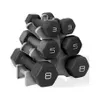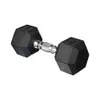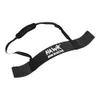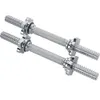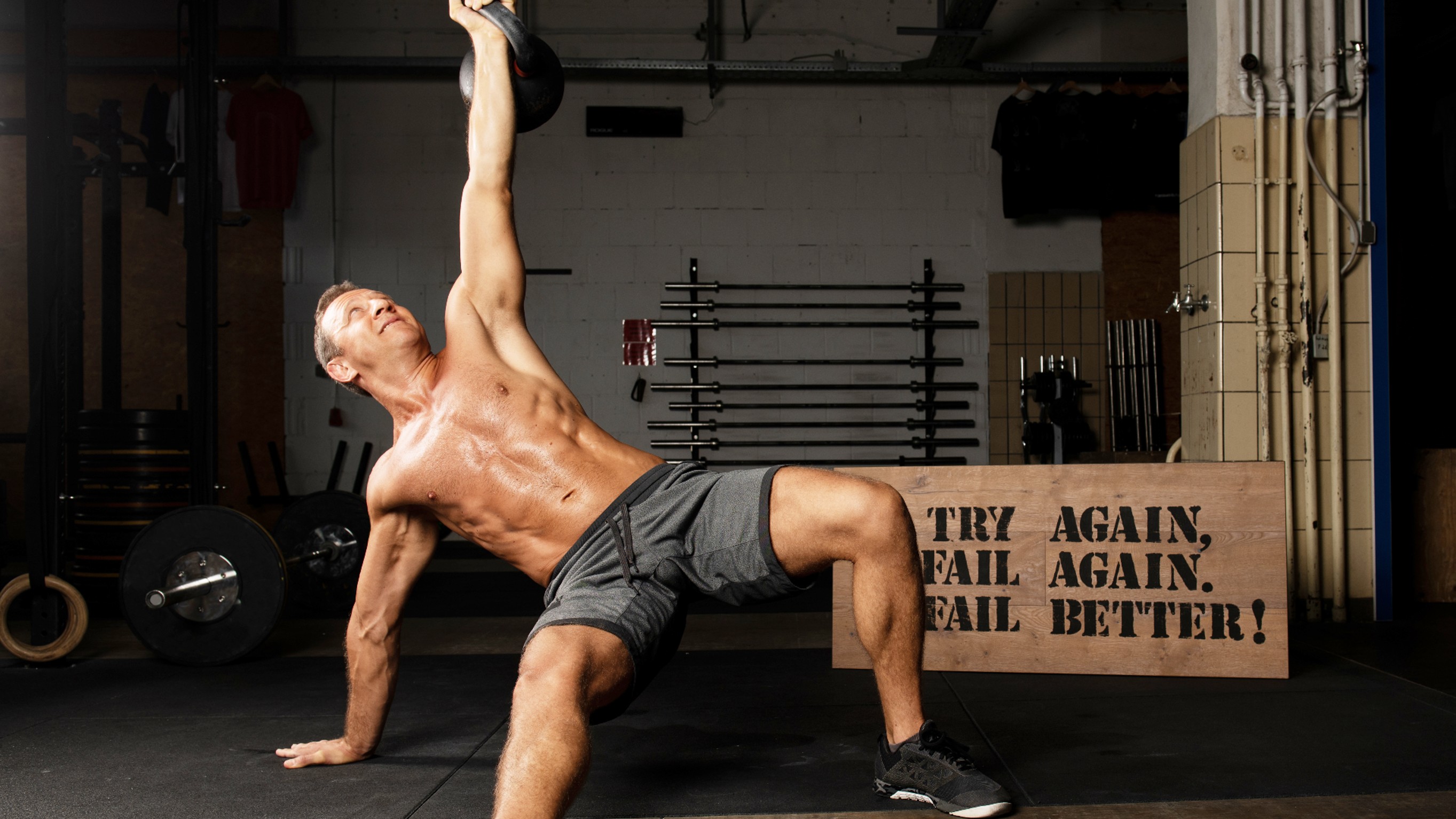
A Turkish get-up might be driven by your core, but it also hits nearly every muscle in your body. So, I did it every day, 70 times, for one week. If you need new ways to challenge your body, add this exercise to your strength program.
If you haven’t seen the Turkish get-up before, this muscle-torching technical compound exercise involves transitioning from lying to standing while holding a weight extended overhead. Not just a core exercise, it’s a brilliant addition to any strength program or abs workout and requires muscular stability, control and full-body engagement.
The move hits your major muscle groups and stabilizer muscles responsible for balance and coordination, recruiting muscles such as your shoulders, triceps, back, hip flexors, core, quads, glutes, hamstrings and calves, to name a few. I used a dumbbell, which is easier to grip, but you can use any weight type or your body weight to master it. Find out what happened after a week of get-ups and why I might not get down with them again — for a while.
How to do Turkish get-ups
Practice using your body weight until the movement pattern feels comfortable, then slowly build up weight — we recommend the best adjustable dumbbells. Make sure you have control at all times. But if that sounds too much, try a half-Turkish get-up variation suitable for beginners from this 4-move workout.
How:
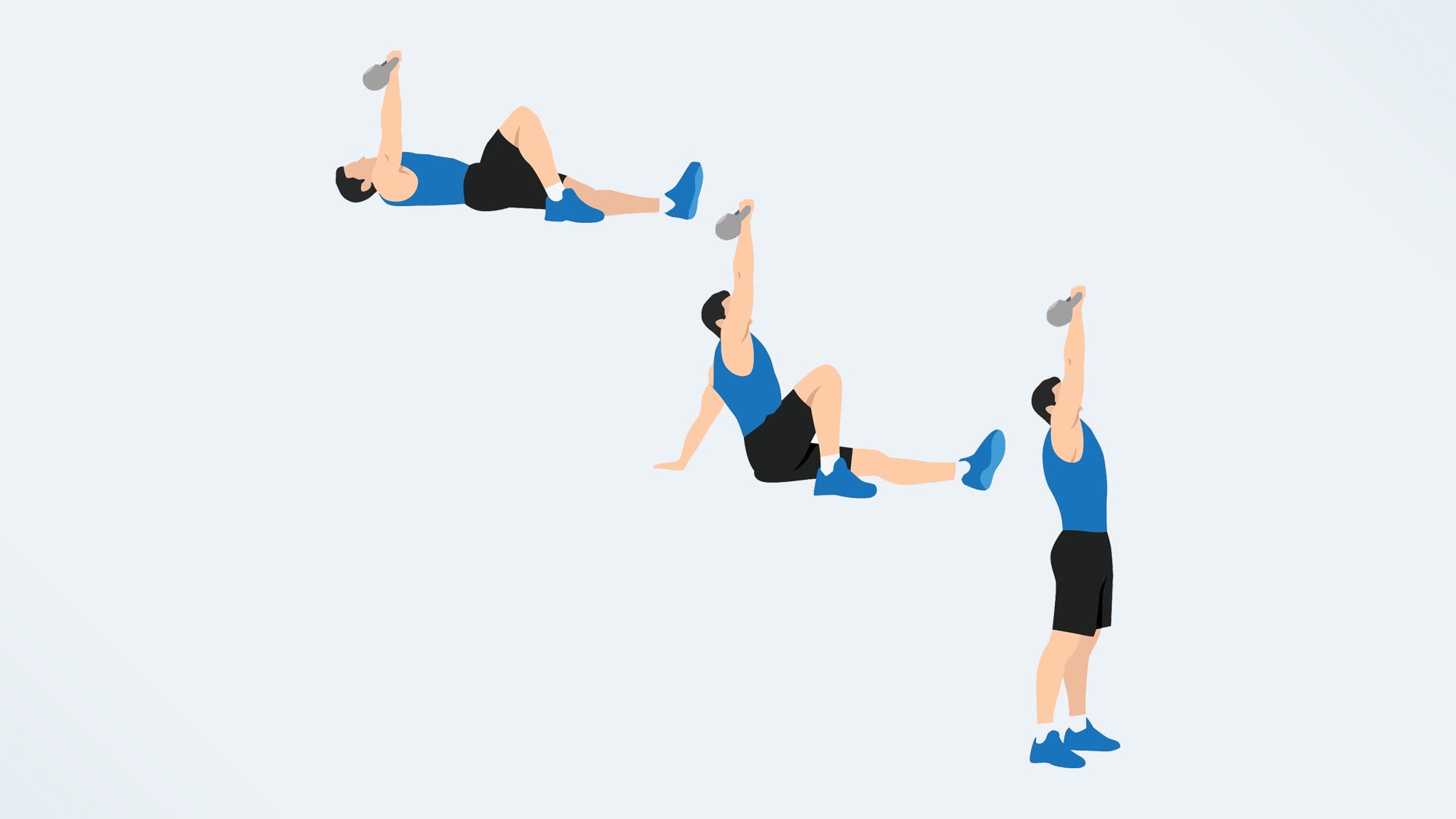
- Start lying down, gripping your weight in your right hand using an underhand grip
- Engage your core and extend your right arm overhead in line with your shoulder
- Bend your right knee and plant your right foot onto the ground. Extend your left leg away from you and rest your left arm next to your body
- Contract your upper body muscles and tuck your chin
- Drive upwards to sit up and rest your left elbow on the floor next to your body
- Keep the weight punching overhead in line with your shoulder and arm locked out. Look at your weight at all times
- Push upwards again and transition from the left elbow to the left hand on the ground, arm now straight
- Push through your right heel and lift your hips upward
- Sweep your left leg behind you and place your left knee down under your hip into a half-kneeling position
- Lift your left arm and straighten your torso
- Keep your right arm locked overhead as you push through your front foot to stand, left leg meeting right hip-width apart
- Pause, then step your left leg back into a reverse lunge, knee resting on the ground
- Reverse each step back down. Switch sides.
I did 70 Turkish get-ups every day for a week to strengthen my core — here are my results
Here’s how it went.
Days 1 and 2
Day one, I was nervous. This has never been my strongest exercise.
Sign up to get the BEST of Tom's Guide direct to your inbox.
Get instant access to breaking news, the hottest reviews, great deals and helpful tips.
I started with 3 sets of 20 reps (10 per side) with 60-90 seconds rest, then hammered out the last 10. I used a tried-and-tested shoulder and hip mobility routine and then moved on to a few warm-up tests using my body weight and very light weights.
During the main sets, I chose a 7.5kg dumbbell for the first, 10kg for the second and third, then graduated to 12.5kg for the last. It’s crucial to practice using your bodyweight and warm-up weights first, as get-ups demand tons of shoulder stability, muscular control and balance to pull off safely.
After my first 70 reps, my shoulders and core were switched on and torched. On day two, I repeated the same process, feeling more comfortable with the movement pattern and beginning to find a good rhythm.
Days 3 and 4

It’s easy to get wrong in many ways, and I still fall into a few traps. It’s about practice, practice and practice.
Firstly, whichever arm is locked out overhead must stay that way — no bending the elbow or waving your arm around. Secondly, you should always aim to keep your gaze on the weight as you move, especially during the transition from floor to kneeling. It’ll help you balance and transition better.
I find the most challenging part is transitioning from seated to half-kneel. During this phase, I focused on driving my hips as high as possible, providing enough room to sweep my leg to a kneeling position.
From here, the body has a stable place to stand. That’s why practicing with body weight first is crucial for developing the skill without the extra challenge of weights. I stumbled multiple times on my left side.
If you struggle with tight hip flexors, you might find it an area of continual improvement, but strengthening your hip flexors using a decent hip mobility routine could help. And the payoff is worth it. Turkish get-ups could improve hip-hinge technique for exercises like deadlifts.
Days 5 and 6
The next few days were about honing the skill and becoming more and more confident. By the sixth day, I’d settled for consistently using the 12.5kg dumbbell. As a caveat, I don’t recommend graduating to weights quickly, but I had some previous experience with Turkish get-ups from CrossFit workouts.
Toward the end of the week, I practiced using a kettlebell — the ‘traditional’ method. They’re harder to control and require good grip and forearm strength to keep the weight resting against the forearm without your wrist sitting in flexion. Naturally, I had to scale back on weight until I felt more confident, but it was fun to mix it up. We cover how to hold a kettlebell properly here.
At this stage, my entire body was achy and sore from DOMS. I felt it most in my shoulders, back and core muscles, and my left shoulder started to feel weak. I already have a dodgy rotator cuff and chose to scale back for the last day to avoid the wrath of my chiropractor.
Day 7
Turkish get-ups build full-body strength, improving posture, stability and coordination and activating neglected smaller, stabilizing muscles. My body felt cooked by day seven, and my oblique muscles felt sore.
The body moves in various directions — twisting, bending, extending and flexing as you transition, which engages your entire trunk, including the deep core muscles, obliques, lats, traps and erector spinae (muscles that hug your spine). It's an all-over Turkish torture.
Verdict
This challenge nearly defeated me several times and delivered a technical masterclass. I had to be patient, focus and take my time — something I’m not adept at — rather than tapping into my need for speed. It’s a top exercise for the health of your core, shoulders and hips, but not for 490 reps. If you’re new to the Turkish get-up, start with 2-3 sets of 10-12 reps, and don’t lead with your ego.
More from Tom's Guide
- Forget kettlebells or planks, this dumbbell workout sculpts muscles with 5 rounds in 20 minutes
- This 6-move calisthenics workout builds functional muscles and endurance
- Forget dumbbells, this 6-move stability ball workout sculpts strong abs.

Sam Hopes is a level 3 qualified trainer, level 2 reiki practitioner and senior fitness writer at Tom's Guide. She is also currently undertaking her Yoga For Athletes training course. Sam has written for various fitness brands and websites over the years and has experience across brands at Future such as Live Science, Fit&Well, Coach, and T3.
Having worked with fitness studios like F45 and Virgin Active, Sam now primarily teaches outdoor bootcamps, bodyweight, calisthenics and kettlebells. She also coaches mobility and stretching-focused classes several times a week and believes that true strength comes from a holistic approach to training your body.
Sam has completed two mixed doubles Hyrox competitions in London and the Netherlands and finished her first doubles attempt in 1:11.
You must confirm your public display name before commenting
Please logout and then login again, you will then be prompted to enter your display name.

